Chapter 14 Waves
Multiple Choice Questions (MCQs)
1. Water waves produced by a motorboat sailing in water are
(a) neither longitudinal nor transverse
(b) both longitudinal and transverse
(c) only longitudinal
(d) only transverse
Show Answer
Answer (b) Water waves produced by a motorboat sailing in water are both longitudinal and transverse, because the waves, produce transverse as well as lateral vibrations in the particles of the medium.2. Sound waves of wavelength $\lambda$ travelling in a medium with a speed of $v m / s$ enter into another medium where its speed in $2 v m / s$. Wavelength of sound waves in the second medium is
(a) $\lambda$
(b) $\frac{\lambda}{2}$
(c) $2 \lambda$
(d) $4 \lambda$
Show Answer
Answer (c) Let the frequency in the first medium is $v$ and in the second medium is $v$.’ Frequency remains same in both the medium
So,
$$ v=v^{\prime} \Rightarrow \frac{v}{\lambda}=\frac{v^{\prime}}{\lambda^{\prime}} $$
$$ \Rightarrow \quad \lambda^{\prime}=(\frac{v^{\prime}}{v}) \lambda $$
$\lambda$ and $\lambda^{\prime}, v$ and $v^{\prime}$ are wavelengths and speeds in first and second medium respectively.
So,
$$ \lambda^{\prime}=(\frac{2 v}{v}) \lambda=2 \lambda $$
3. Speed of sound wave in air
(a) is independent of temperature
(b) increases with pressure
(c) increases with increase in humidity
(d) decreases with increase in humidity
Show Answer
Answer (c) Due to presence of moisture density of air decreases.
We know that speed of sound in air is given by $v=\sqrt{\frac{\gamma p}{\rho}}$
For air $\gamma$ and $p$ are constants.
$$ \begin{aligned} & v \propto \frac{1}{\sqrt{\rho}}, \text { where } \rho \text { is density of air. } \\ & \frac{v_2}{v_1}=\sqrt{\frac{\rho_2}{\rho_1}} \end{aligned} $$
where $\rho_1$ is density of dry air and $\rho_2$ is density of moist air.
As $\quad \rho_2<\rho_1=\frac{v_2}{v_1}>1 \Rightarrow v_2>v_1$
Hence, speed of sound wave in air increases with increase in humidity.
4. Change in temperature of the medium changes
(a) frequency of sound waves
(b) amplitude of sound waves
(c) wavelength of sound waves
(d) loudness of sound waves
Show Answer
Answer (c) Speed of sound wave in a medium $v \propto \sqrt{T}$ (where $T$ is temperature of the medium) Clearly, when temperature changes speed also changes.
As,
$$ v=v \lambda $$
where $v$ is frequency and $\lambda$ is wavelength.
Frequency $(v)$ remains fixed
$\Rightarrow \quad v \propto \lambda$ or $\lambda \propto v$
As does not change, so wavelength $(\lambda)$ changes.
5. With propagation of longitudinal waves through a medium, the quantity transmitted is
(a) matter
(b) energy
(c) energy and matter
(d) energy, matter and momentum
Show Answer
Answer (b) Propagation of longitudinal waves through a medium leads to transmission of energy through the medium without matter being transmitted.
There is no movement of matter (mass) and hence momentum.
6. Which of the following statements are true for wave motion?
(a) Mechanical transverse waves can propagate through all mediums
(b) Longitudinal waves can propagate through solids only
(c) Mechanical transverse waves can propagate through solids only
(d) Longitudinal waves can propagate through vacuum
Show Answer
Answer (c) When mechanical transverse wave propagates through a medium, the constituent of the medium oscillate perpendicular to wave motion causing change in shape. That is each, element of the medium is subjected to shearing stress. Solids and strings have shear modulus, that is why, sustain shearing stress.
Fluids have no shape of, their own, they yield to shearing stress. This is why transverse waves are possible in solids and strings but not in fluids.
7. A sound wave is passing through air column in the form of compression and rarefaction. In consecutive compressions and rarefactions,
(a) density remains constant
(b) Boyle’s law is obeyed
(c) bulk modulus of air oscillates
(d) there is no transfer of heat
Show Answer
Answer (d) (a) Due to compression and rarefactions density of the medium (air) changes. At compressed regions density is maximum and at rarefactions density is minimum
(b) As density is changing, so Boyle’s law is not obeyed
(c) Bulk modulus remains same
(d) The time of compression and rarefaction is too small i.e., we can assume adiabatic process and hence no transfer of heat
8. Equation of a plane progressive wave is given by $y=0.6 \sin 2 \pi(t-\frac{x}{2})$.0n reflection from a denser medium its amplitude becomes $\frac{2}{3}$ of the amplitude of the incident wave. The equation of the reflected wave is
(a) $y=0.6 \sin 2 \pi(t+\frac{x}{2})$
(b) $y=-0.4 \sin 2 \pi(t+\frac{x}{2})$
(c) $y=0.4 \sin 2 \pi(t+\frac{x}{2})$
(d) $y=-0.4 \sin 2 \pi(t-\frac{x}{2})$
Show Answer
Thinking Process
Due to reflection from a denser medium there is a phase change of $180^{\circ}$ in the reflected wave.
Answer (b) Amplitude of reflected wave
$$ A_{r}=\frac{2}{3} \times A_{i}=\frac{2}{3} \times 0.6=0.4 \text { units } $$
Given equation of incident wave
$$ y_{i}=0.6 \sin 2 \pi(t-\frac{x}{2}) $$
Equation of reflected wave is
$$ y_{r}=A_{r} \sin 2 \pi(t+\frac{x}{2}+\pi) $$
[ $\because$ At denser medium, phase changes by $\pi]$ The positive sign is due to reversal of direction of propagation
So,
$$ y_{r}=-0.4 \sin 2 \pi(t+\frac{x}{2}) \quad[\because \sin (\pi+\theta)=-\sin \theta] $$
9. A string of mass $2.5 kg$ is under tension of $200 N$. The length of the stretched string is $20.0 m$. If the transverse jerk is struck at one end of the string, the disturbance will reach the other end in
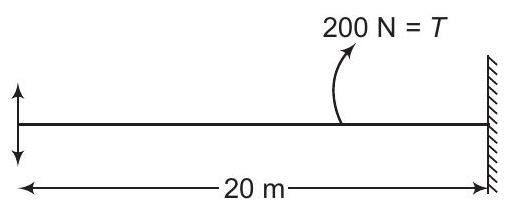
(a) $1 s$
(b) $0.5 s$
(c) $2 s$
(d) data given is insufficient
Show Answer
Answer (b)
Mass $m=2.5 kg$
$$ \mu=\text { mass per unit length } $$
$$ \begin{aligned} & =\frac{m}{l}=\frac{2.5 kg}{20}=\frac{1.25}{10}=0.125 kg / m \\ \text { Speed } v & =\sqrt{\frac{T}{\mu}}=\sqrt{\frac{200}{0.125}} \quad \text { [speed of transverse waves in any string] } \\ l & =v \times t \Rightarrow 20=\sqrt{\frac{200}{0.125}} \times t \\ t & =20 \times \sqrt{\frac{125}{2 \times 10^{5}}}=20 \times \sqrt{\frac{25 \times 5}{2 \times 10^{5}}} \\ & =20 \times \sqrt{25 \times \frac{1}{0.4 \times 10^{5}}} \\ & =20 \times 5 \sqrt{\frac{1}{4 \times 10^{4}}}=\frac{20 \times 5}{2 \times 10^{2}} \\ & =\frac{1}{2}=0.5 \end{aligned} $$
10. A train whistling at constant frequency is moving towards a station at a constant speed $v$. The train goes past a stationary observer on the station. The frequency $n^{\prime}$ of the sound as heard by the observer is plotted as a function of time $t$ (figure). Identify the expected curve.

Show Answer
Thinking Process
The observed frequency is apparent frequency due to Doppler shift.
Answer (c) Let the original frequency of the source is $n_0$. Let the speed of sound wave in the medium is $v$.
As observer is stationary
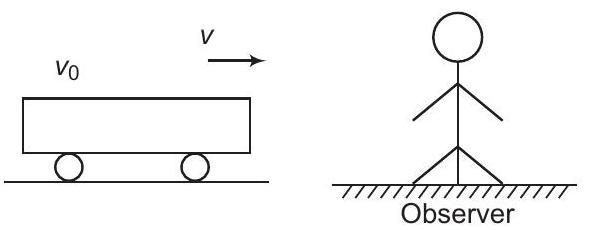
Apparent frequency $n_{a}=(\frac{v}{v-v_{s}}) n_0$
[when train is approaching]
$$ =(\frac{v}{v-v_{s}}) n_0=n_{a}>n_0 $$
When the train is going away from the observer
Apparent frequency $n_{a}=(\frac{v}{v+v_{s}}) n_{o}=n_{a}<n_{o}$
Hence, the expected curve is (c).
Multiple Choice Questions (More Than One Options)
11. A transverse harmonic wave on a string is described by
$$ y(x, t)=3.0 \sin (36 t+0.018 x+\frac{\pi}{4}) $$
where $x$ and $y$ are in $cm$ and $t$ is in sec. The positive direction of $x$ is from left to right.
(a) the wave is travelling from right to left
(b) the speed of the wave is $20 m / s$
(c) frequency of the wave is $5.7 Hz$
(d) the least distance between two successive crests in the wave is $2.5 cm$
Show Answer
Thinking Process
To find the characteristic parameters associated with a wave, compare the given equation of the wave with a standard equation.
Answer $(a, b, c)$
Given equation is
$$ y(x, t)=3.0 \sin (36 t+0.018 x+\frac{\pi}{4}) $$
Compare the equation with the standard form.
$$ y=a \sin (\omega t+k x+\phi) $$
(a) As the equation involves positive sign with $x$, hence the wave is travelling from right to left. Hence, option (a) is correct.
(b) Given
$\omega=36 \Rightarrow 2 \pi v=36$
$\Rightarrow$
$v=$ frequency $=\frac{36}{2 \pi}=\frac{18}{\pi}$
$k=0.018 \Rightarrow \frac{2 \pi}{\lambda}=0.018$
$$ \begin{aligned} & \Rightarrow \quad \frac{2 \pi v}{v \lambda}=0.018 \Rightarrow \frac{\omega}{v}=0.018 \quad[\because 2 \pi v=\omega \text { and } v \lambda=v] \\ & \Rightarrow \quad \frac{36}{V}=0.018=\frac{18}{1000} \\ & \Rightarrow \quad v=2000 cm / s=20 m / s \end{aligned} $$
(c) $2 \pi v=36$
$$ \Rightarrow \quad v=\frac{36}{2 \pi} Hz=\frac{18}{\pi}=5.7 Hz $$
(d) $\frac{2 \pi}{\lambda}=0.018$
$$ \begin{aligned} \Rightarrow \quad \lambda & =\frac{2 \pi}{0.018} cm \\ & =\frac{2000 \pi}{18} cm=\frac{20 \pi}{18} m=3.48 cm \end{aligned} $$
Hence, least distance between two successive crests $=\lambda=3.48 m$.
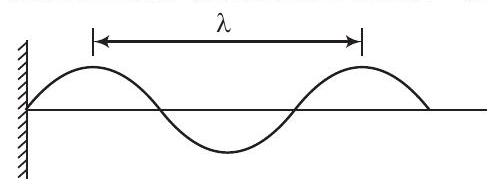
12. The displacement of a string is given by
$$ y(x, t)=0.06 \sin (\frac{2 \pi x}{3}) \cos (120 \pi t) $$
where $x$ and $y$ are in metre and $t$ in second. The length of the string is 1.5 $m$ and its mass is $3.0 \times 10^{-2} kg$.
(a) It represents a progressive wave of frequency $60 Hz$
(b) It represents a stationary wave of frequency $60 Hz$
(c) It is the result superposition of two waves of wavelength $3 m$, frequency $60 Hz$ each travelling with a speed of $180 m / s$ in opposite direction
(d) Amplitude of this wave is constant
Show Answer
Answer (b, c)
Given equation is
$$ y(x, t)=0.06 \sin (\frac{2 \pi x}{3}) \cos (120 \pi t) $$
(a) Comparing with a standard equation of stationary wave
$$ y(x, t)=a \sin (k x) \cos (\omega t) $$
Clearly, the given equation belongs to stationary wave. Hence, option (a) is not correct.
(b) By comparing,
$$ \begin{aligned} & \omega & =120 \pi \\ \Rightarrow & 2 \pi f & =120 \pi \Rightarrow f=60 Hz \end{aligned} $$
(c) $k=\frac{2 \pi}{3}=\frac{2 \pi}{\lambda}$
$$ \Rightarrow \begin{aligned} \lambda & =\text { wavelength }=3 m \\ \text { Frequency } & =f=60 Hz \\ \text { Speed } & =v=f \lambda=(60 Hz)(3 m)=180 m / s \end{aligned} $$
(d) Since in stationary wave, all particles of the medium execute SHM with varying amplitude ’nodes.
13. Speed of sound wave in a fluid depends upon
(a) directly on density of the medium
(b) square of Bulk modulus of the medium
(c) inversly on the square root of density
(d) directly on the square root of bulk modulus of the medium
Show Answer
Answer (c, $d)$
Speed of sound waves in a fluid is given by $v=\sqrt{\frac{B}{\rho}}$, where $B$ is Bulk modulus and $\rho$ is density of the medium.
Clearly,
and
$$ \begin{matrix} v \propto \frac{1}{\sqrt{\rho}} & {[\therefore \text { for any fluid, } B=\text { constant }]} \\ v \propto \sqrt{B} & {[\because \text { for medium, } \rho=\text { constant }]} \end{matrix} $$
14. During propagation of a plane progressive mechanical wave,
(a) all the particles are vibrating in the same phase
(b) amplitude of all the particles is equal
(c) particles of the medium executes SHM
(d) wave velocity depends upon the nature of the medium
Show Answer
Answer ( $b, c, d)$
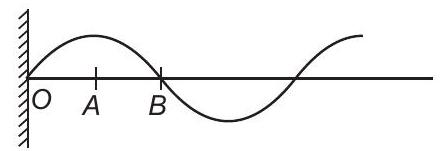
During propagation of a plane progressive mechanical wave, like shown in the diagram, amplitude of all the particles is equal.
(i) Clearly, the particles $O, A$ and $B$ are having different phase.
(ii) Particles of the wave shown in the figure are having up and down SHM.
(iii) For a progressive wave propagating in a fluid.
Hence,
$$ \begin{aligned} \text { Speed } & =v=\sqrt{\frac{B}{\rho}} \\ v & \propto \sqrt{\frac{1}{\rho}} \end{aligned} $$
$$ [\because B \text { is constant }] $$
As $\rho$ depends upon nature of the medium, hence $v$ also depends upon the nature of the medium.
15. The transverse displacement of a string (clamped at its both ends) is given by $y(x, t)=0.06 \sin (\frac{2 \pi x}{3}) \cos (120 \pi t)$.
All the points on the string between two consecutive nodes vibrate with
(a) same frequency
(b) same phase
(c) same energy
(d) different amplitude
Show Answer
Answer $(a, b, d)$
Given equation is
$$ y(x, t)=0.06 \sin (\frac{2 \pi}{3} x) \cos (120 \pi t) $$
Comparing with standard equation of stationary wave
$$ y(x, t)=a \sin (k x) \cos (\omega t) $$
It is represented by diagram.
where $N$ denotes nodes and $A$ denotes antinodes.

(a) Clearly, frequency is common for all the points.
(b) Consider all the particles between two nodes they are having same phase of $(120 \pi t)$ at a given time.
(c) and (d) But are having different amplitudes of $0.06 \sin (\frac{2 \pi}{3} x)$ and because of different amplitudes they are having different energies.
16. A train, standing in a station yard, blows a whistle of frequency $400 Hz$ in still air. The wind starts blowing in the direction from the yard to the station with a speed of $10 m / s$. Given that the speed of sound in still air is $340 m / s$. Then
(a) the frequency of sound as heard by an observer standing on the platform is $400 Hz$
(b) the speed of sound for the observer standing on the platform is $350 m / s$
(c) the frequency of sound as heard by the observer standing on the platform will increase
(d) the frequency of sound as heard by the observer standing on the platform will decrease
Show Answer
Thinking Process
When the wind is blowing in the same direction as that of sound wave then net speed of the wave is sum of speed of sound wave and speed of the wind.
Answer ( $a, b$ )
Given,
Speed of wind
$$ \begin{aligned} & v_0=400 Hz, v=340 m / s \\ & v_{w}=10 m / s \end{aligned} $$
(a) As both source and observer are stationary, hence frequency observed will be same as natural frequency $v_0=400 Hz$
(b) The speed of sound $v=v+v_{w}$
$$ =340+10=350 m / s $$
(c) and (d) There will be no effect on frequency,because there is no relative motion between source and observer hence (c),(d) are incorrect.
17. Which of the following statement are true for a stationary waves?
(a) Every particle has a fixed amplitude which is different from the amplitude of its nearest particle
(b) All the particles cross their mean position at the same time
(c) All the particles are oscillating with same amplitude
(d) There is no net transfer of energy across any plane
(e) There are some particles which are always at rest
Show Answer
Answer $(a, b, d, e)$
Consider the equation of a stationary wave $y=a \sin (k x) \cos \omega t$
(a) clearly every particle at $x$ will have amplitude $=a \sin k x=$ fixed
(b) for mean position $y=0$
$$ \begin{matrix} \Rightarrow & & \cos \omega t & =0 \\ \Rightarrow & \omega t & =(2 n-1) \frac{\pi}{2} \end{matrix} $$
Hence, for a fixed value of $n$, all particles are having same value of
$$ \text { timet }=(2 n-1) \frac{\pi}{2 \omega} \quad[\because \omega=\text { constant }] $$
(c) amplitude of all the particles are a $\sin (k x)$ which is different for different particles at different values of $x$
(d) the energy is a stationary wave is confined between two nodes
(e) particles at different nodes are always at rest.
Very Short Answer Type Questions
18. A sonometer wire is vibrating in resonance with a tuning fork. Keeping the tension applied same, the length of the wire is doubled. Under what conditions would the tuning fork still be is resonance with the wire?
Show Answer
Answer Wire of twice the length vibrates in its second harmonic. Thus, if the tuning fork resonates at $L$, it will resonate at $2 L$. This can be explained as below
The sonometer frequency is given by
$$ v=\frac{n}{2 L} \sqrt{\frac{T}{m}} \quad(n=\text { number of loops }) $$
Now, as it vibrates with length $L$, we assume $v=v_1$
$$ \begin{aligned} n & =n_1 \\ \therefore \quad v_1 & =\frac{n_1}{2 L} \sqrt{\frac{T}{m}} \end{aligned} $$
When length is doubled, then
$$ v_2=\frac{n_2}{2 \times 2 L} \sqrt{\frac{T}{m}} $$
Dividing Eq. (i) by Eq. (ii), we get
$$ \frac{v_1}{v_2}=\frac{n_1}{n_2} \times 2 $$
To keep the resonance
$$ \begin{aligned} & \frac{v_1}{v_2}=1=\frac{n_1}{n_2} \times 2 \\ \Rightarrow \quad & n_2=2 n_1 \end{aligned} $$
Hence, when the wire is doubled the number of loops also get doubled to produce the resonance. That is it resonates in second harmonic.
19. An organ pipe of length $L$ open at both ends is found to vibrate in its first harmonic when sounded with a tuning fork of $480 Hz$. What should be the length of a pipe closed at one end, so that it also vibrates in its first harmonic with the same tuning fork?
Show Answer
Thinking Process
We should not confuse between pressure wave and displacement wave. By considering any type of wave outcome will be same.
Answer Consider the situation shown in the diagram
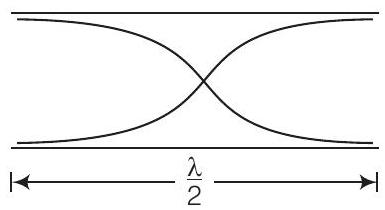
As the organ pipe is open at both ends, hence for first harmonic
$$ \begin{gathered} l=\frac{\lambda}{2} \\ \Rightarrow \quad \lambda=2 l \Rightarrow \frac{c}{v}=2 l \Rightarrow v=\frac{c}{2 l} \end{gathered} $$
where $c$ is speed of the sound wave in air.
For pipe closed at one end
$$ v^{\prime}=\frac{C}{4 L^{\prime}} $$
c for first harmonic
Hence,
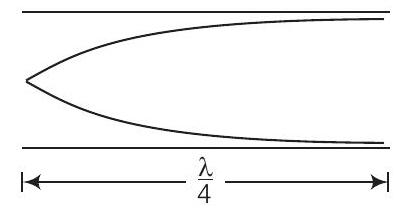
$$ \begin{matrix} \Rightarrow & \frac{C}{2 L} & =\frac{C}{4 L^{\prime}} \\ \Rightarrow & \frac{L^{\prime}}{L} & =\frac{2}{4}=\frac{1}{2} \Rightarrow L^{\prime}=\frac{L}{2} \end{matrix} $$
20. A tuning fork $A$, marked $512 Hz$, produces 5 beats per second, where sounded with another unmarked tuning fork $B$. If $B$ is loaded with wax the number of beats is again 5 per second. What is the frequency of the tuning fork $B$ when not loaded?
Show Answer
Answer Frequency of tuning fork $A$,
$$ v_{A}=512 Hz $$
Probable frequency of tuning fork $B$,
$$ v_{B}=v_{A} \pm 5=512 \pm 5=517 \text { or } 507 Hz $$
when $B$ is loaded, its frequency reduces.
If it is $517 Hz$, it might reduced to $507 Hz$ given again a beat of $5 Hz$.
If it is $507 Hz$, reduction will always increase the beat frequency, hence $v_{B}=517 Hz$
Note For production of beats frequencies of the two tuning forks must be nearly equal i.e., slight difference in frequencies.
21. The displacement of an elastic wave is given by the function $y=3 \sin \omega t+4 \cos \omega t$, where $y$ is in $cm$ and $t$ is in second. Calculate the resultant amplitude.
Show Answer
Answer Given, displacement of an elastic wave $y=3 \sin \omega t+4 \cos \omega t$ Assume,
$$ 3=a \cos \phi $$
$$ 4=a \sin \phi $$
On dividing Eq. (ii) by Eq. (i)
Also, $\quad a^{2} \cos ^{2} \phi+a^{2} \sin ^{2} \phi=3^{2}+4^{2}$
$\Rightarrow \quad a^{2}(\cos ^{2} \phi+\sin ^{2} \phi)=25$
Hence,
where
$$ a^{2} \cdot 1=25 \Rightarrow a=5 $$
Hence, amplitude $=5 cm$
22. A sitar wire is replaced by another wire of same length and material but of three times the earlier radius. If the tension in the wire remains the same, by what factor will the frequency change?
Show Answer
Thinking Process
In a sitar wire, the vibration is assumed to be similar as a wire fixed at both ends.
Answer Frequency of vibrations produced by a stretched wire
$$ \begin{aligned} & v=\frac{n}{2 l} \sqrt{\frac{T}{\mu}} \\ & \text { Mass per unit length } \mu=\frac{\text { Mass }}{\text { Length }}=\frac{\pi r^{2} l \rho}{l}=\pi r^{2} \rho \quad[\because M=v p=A l \rho=\pi r^{2} l \rho] \\ & \therefore \quad v=\frac{n}{2 l} \sqrt{\frac{T}{\pi r^{2} \rho}} \Rightarrow v \propto \sqrt{\frac{1}{r^{2}}} \\ & v \propto \frac{1}{r} \\ & \text { Hence, when radius is tripled, } v \text { will be } \frac{1}{3} rd \text { of previous value. } \end{aligned} $$
23. At what temperatures $(.$ in $.^{\circ} C)$ will the speed of sound in air be 3 times its value at $0^{\circ} C$ ?
Show Answer
Answer We know that speed of sound in air $v \propto \sqrt{T}$
$ \therefore \frac{v_{T}}{v_0} =\sqrt{\frac{T_{T}}{T_0}}=\sqrt{\frac{T_{T}}{273}}$
$\text { But } \frac{v_{T}}{v_0} =\frac{3}{1} $
$\therefore \frac{3}{1} =\sqrt{\frac{T_{T}}{T_0}} \Rightarrow \frac{T_{T}}{273}=9 $
$\therefore \quad \text { [where } T \text { is in kelvin] }$
$ T_{T} =273 \times 9=2457 K$
$ =2457-273=2184^{\circ} C$
24. When two waves of almost equal frequencies $n_1$ and $n_2$ reach at a point simultaneously, what is the time interval between successive maxima?
Show Answer
Thinking Process
When two waves of almost equal frequencies interfere, they are producing beats.
Answer Let,
Beat frequency
$$ \begin{aligned} & n_1>n_2 \\ & v_{b}=n_1-n_2 \end{aligned} $$
Time period of beats $=T_{b}=\frac{1}{v_{b}}=\frac{1}{n_1-n_2}$
Short Answer Type Questions
25. A steel wire has a length of $12 m$ and a mass of $2.10 kg$. What will be the speed of a transverse wave on this wire when a tension of $2.06 \times 10^{4} N$ is applied?
Show Answer
Answer Given, length of the wire
Mass of wire
Tension
Speed of transverse wave
$$ \begin{aligned} l & =12 m \\ m & =2.10 kg \\ T & =2.06 \times 10^{4} N \\ v & =\sqrt{\frac{T}{\mu}} \quad \quad \quad[\text { where } \mu=\text { mass per unit length] } \\ & =\sqrt{\frac{2.06 \times 10^{4}}{(\frac{2.10}{12})}}=\sqrt{\frac{2.06 \times 12 \times 10^{4}}{2.10}}=343 m / s \end{aligned} $$
26. A pipe $20 cm$ long is closed at one end. Which harmonic mode of the pipe is resonantly excited by a source of $1237.5 Hz$ ? (sound velocity in air $=330 ms^{-1}$ )
Show Answer
Answer Length of pipe
$$ \begin{aligned} l & =20 \mathrm{~cm}=20 \times 10^{-2} \mathrm{~m} \\ v_{\text {funda }} & =\frac{V}{4 L}=\frac{330}{4 \times 20 \times 10^{-2}} \quad \quad \quad \text{(for closed pipe)} \\ v_{\text {funda }} & =\frac{330 \times 100}{80}=412.5 \mathrm{~Hz} \\ \frac{v_{\text {given }}}{v_{\text {funda }}} & =\frac{1237.5}{412.5}=3 \end{aligned} $$
Hence, 3rd harmonic node of the pipe is resonantly excited by the source of given frequency.
27. A train standing at the outer signal of a railway station blows a whistle of frequency $400 Hz$ still air. The train begins to move with a speed of $10 ms^{-1}$ towards the platform. What is the frequency of the sound for an observer standing on the platform? (sound velocity in air $=330 ms^{-1}$ )
Show Answer
Answer As the source (train) is moving towards the observer (platform) hence apparent frequency observed is more than the natural frequency.
Frequency of whistle
Speed of train
Velocity of sound in air
$$ \begin{aligned} v & =400 Hz \\ v_{t} & =10 m / s \\ v & =330 m / s \end{aligned} $$
Apparent frequency when source is moving $v_{app}=(\frac{v}{v-v_{t}}) v$
$$ \begin{aligned} & =(\frac{330}{330-10}) 400 \\ \Rightarrow \quad v_{\text {app }} & =\frac{330}{320} \times 400=412.5 Hz \end{aligned} $$
28. The wave pattern on a stretched string is shown in figure. Interpret what kind of wave this is and find its wavelength.
Show Answer
Answer We have to observe the displacement and position of different points, then accordingly nature of two wave is decided.
Points on positions $x=10,20,30,40$ never move, always at mean position with respect to time. These are forming nodes which characterise a stationary wave.
$\because$ Distance between two successive nodes $=\frac{\lambda}{2}$
$\Rightarrow$
$$ \begin{aligned} \lambda & =2 \times(\text { node to node distance }) \\ & =2 \times(20-10) \\ & =2 \times 10=20 cm \end{aligned} $$
29. The pattern of standing waves formed on a stretched string at two instants of time are shown in figure. The velocity of two waves superimposing to form stationary waves is $360 ms^{-1}$ and their frequencies are $256 Hz$.
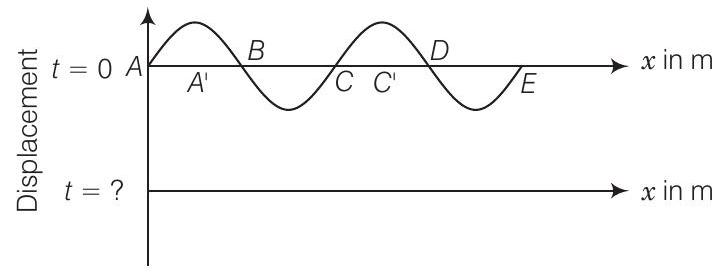
(a) Calculate the time at which the second curve is plotted.
(b) Mark nodes and antinodes on the curve.
(c) Calculate the distance between $A^{\prime}$ and $C^{\prime}$.
Show Answer
Answer Given, frequency of the wave $v=256 Hz$
Time period
$$ T=\frac{1}{v}=\frac{1}{256} S=3.9 \times 10^{-3} S $$
(a) Time taken to pass through mean position is
$$ t=\frac{T}{4}=\frac{1}{40}=\frac{3.9 \times 10^{-3}}{4} s=9.8 \times 10^{-4} s $$
(b) Nodes are $A, B, C, D, E$ (i.e., zero displacement) Antinodes are $A^{\prime}, C^{\prime}$ (i.e., maximum displacement)
(c) It is clear from the diagram $A^{\prime}$ and $C^{\prime}$ are consecutive antinodes, hence separation $=$ wavelength $(\lambda)$
$$ =\frac{v}{v}=\frac{360}{256}=1.41 m $$
$$ [\therefore v=v \lambda] $$
30. A tuning fork vibrating with a frequency of $512 Hz$ is kept close to the open end of a tube filled with water (figure). The water level in the tube is gradually lowered. When the water level is $17 cm$ below the open end, maximum intensity of sound is heard. If the room temperature is $20^{\circ} C$, calculate
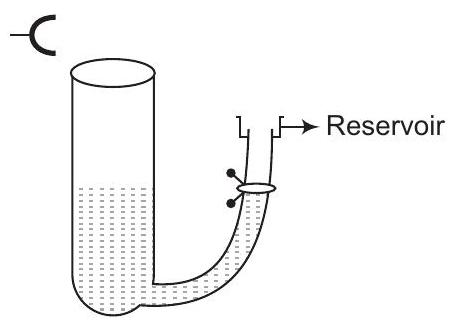
(a) speed of sound in air at room temperature.
(b) speed of sound in air at $0^{\circ} C$.
(c) if the water in the tube is replaced with mercury, will there be any difference in your observations?
Show Answer
Thinking Process
The pipe partially filled with water, acts as closed organ pipe. According to this, we will find associated frequencies.
Answer Consider the diagram frequency of tuning fork $v=512 Hz$.
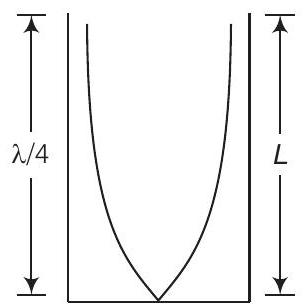
For observation of first maxima of intensity
(a) $L=\frac{\lambda}{4} \Rightarrow \lambda=4 L$
[for closed pipe]
$$ \begin{aligned} v & =v \lambda=512 \times 4 \times 17 \times 10^{-2} \\ & =348.16 m / s \end{aligned} $$
(b) We know that $v \propto \sqrt{T}$
where temperature $(T)$ is in kelvin.
$$ \begin{aligned} \frac{v_{20}}{v_0} & =\sqrt{\frac{273+20}{273+0}}=\sqrt{\frac{293}{273}} \\ \frac{v_{20}}{v_0} & =\sqrt{1.073}=1.03 \\ v_0 & =\frac{v_{20}}{1.03}=\frac{348.16}{1.03}=338 m / s \end{aligned} $$
(c) Resonance will be observed at $17 cm$ length of air column, only intensity of sound heard may be greater due to more complete reflection of the sound waves at the mercury surface because mercury is more denser than water.
31. Show that when a string fixed at its two ends vibrates in 1 loop, 2 loops, 3 loops and 4 loops, the frequencies are in the ratio $1: 2: 3: 4$.
Show Answer
Answer Let, there are $n$ number of loops in the string.
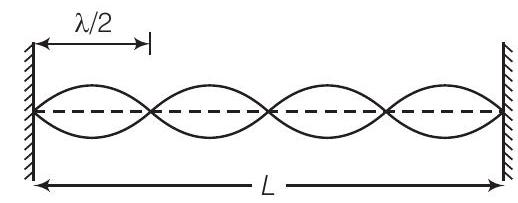
Length corresponding each loop is $\frac{\lambda}{2}$.
Now, we can write
$ L=\frac{n \lambda}{2} \Rightarrow \lambda=\frac{2 L}{n} $
$\Rightarrow \frac{v}{v} =\frac{2 L}{n} \Rightarrow[\because v=v \lambda] $
$\Rightarrow v =\frac{n}{2 L} v=\frac{n}{2 L} \sqrt{\frac{T}{\mu}} \quad[\because \text { velocity of transverse waves }=\sqrt{T / \mu}] $
$\Rightarrow v \propto n \quad[\because \text { length and speed are constants }] $ $\text { So, } $
Long Answer Type Questions
32. The earth has a radius of $6400 km$. The inner core of $1000 km$ radius is solid. Outside it, there is a region from $1000 km$ to a radius of $3500 km$ which is in molten state. Then again from $3500 km$ to $6400 km$ the earth is solid. Only longitudinal $(P)$ waves can travel inside a liquid.
Assume that the $P$ wave has a speed of $8 km s^{-1}$ in solid parts and of $5 km s^{-1}$ in liquid parts of the earth. An earthquake occurs at some place close to the surface of the earth. Calculate the time after which it will be recorded in a seismometer at a diametrically opposite point on the earth, if wave travels along diameter?
Show Answer
Answer Speed of wave in solid $=8 km / s$
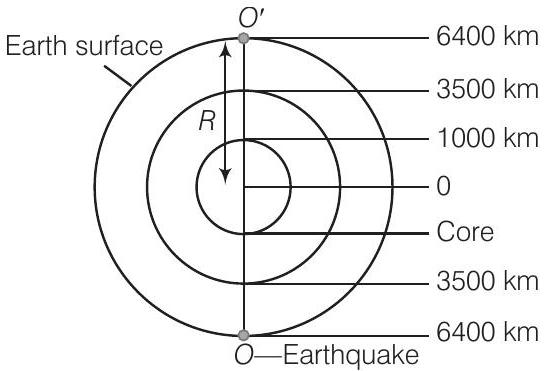
Speed of wave in liquid $=5 km / s$
Required time $=[\frac{1000-0}{8}+\frac{3500-1000}{5}+\frac{6400-3500}{8}] \times 2 \quad[\because$ diameter $=$ radius $\times 2]$
$$ \begin{matrix} =[\frac{1000}{8}+\frac{2500}{5}+\frac{2900}{8}] \times 2 & {[\text { time }=\frac{\text { distance }}{\text { speed }}]} \\ =[125+500+362.5] \times 2=1975 & \end{matrix} $$
As we are considering at diametrically opposite point, hence there is a multiplication of 2.
33. If $c$ is rms speed of molecules in a gas and $v$ is the speed of sound waves in the gas, show that $c / v$ is constant and independent of temperature for all diatomic gases.
Show Answer
Answer We know that rms speed of molecules of a gas
$$ c=\sqrt{\frac{3 p}{\rho}}=\sqrt{\frac{3 R T}{M}} $$
where $M=$ molar mass of the gas.
Speed of sound wave in gas $v=\sqrt{\frac{\gamma \rho}{\rho}}=\sqrt{\frac{\gamma R T}{M}}$
On dividing Eq. (i) by Eq. (ii), we get
$$ \frac{c}{V}=\sqrt{\frac{3 R T}{M} \times \frac{M}{\gamma R T}} \Rightarrow \frac{c}{V}=\sqrt{\frac{3}{\gamma}} $$
where $\gamma=$ adiabatic constant for diatomic gas
Hence,
$$ \gamma=\frac{7}{5} $$
$$ [\text { since } \gamma=\frac{C_{p}}{C_{V}}] $$
34. Given below are some functions of $x$ and $t$ to represent the displacement of an elastic wave.
(i) $y=5 \cos (4 x) \sin (20 t)$
(ii) $y=4 \sin (5 x-t / 2)+3 \cos (5 x-t / 2)$
(iii) $y=10 \cos [(252-250) \pi t] \cos [(252+250) \pi t]$
(iv) $y=100 \cos (100 \pi t+0.5 x)$
State which of these represent
(a) a travelling wave along- $x$-direction
(b) a stationary wave
(c) beats
(d) a travelling wave along- $x$-direction
Given reasons for your answers.
Show Answer
Thinking Process
To predict the nature of wave we have to compare with standard equations.
Answer (a) The equation $y=100 \cos (100 \pi t+0.5 x)$ is representing a travelling wave along $x$-direction.
(b) The equation $y=5 \cos (4 x) \sin (20 t)$ represents a stationary wave, because it contains sin, cos terms i.e., combination of two progressive waves
(c) As the equation $y=10 \cos [(252-250) \pi t] \cdot \cos [(252+250) \pi t]$ involving sum and difference of two near by frequencies 252 and 250 have this equation represents beats formation.
(d) As the equation $y=4 \sin (5 x-t / 2)+3 \cos (5 x-t / 2)$ involves negative sign with $x$, have if represents a travelling wave along $x$-direction.
Note We must not confuse with sign connected with $x$ and direction of propagation of wave. It is just reversed, positive sign with $x$ shown propagation of the wave in negative $x$-direction and vice-versa.
35. In the given progressive wave $y=5 \sin (100 \pi t-0.4 \pi x)$ where $y$ and $x$ are in metre, $t$ is in second. What is the
(a) amplitude?
(b) wavelength?
(c) frequency?
(d) wave velocity?
(e) particle velocity amplitude?
Show Answer
Answer Standard equation of a progressive wave is given by
$$ y=a \sin (\omega t-k x+\phi) $$
This is travelling along positive $x$-direction.
Given equation is $\quad y=5 \sin (100 \pi t-0.4 \pi x)$
Comparing with the standard equation
(a) Amplitude $=5 m$
(b) $k=\frac{2 \pi}{\lambda}=0.4 \pi$
$\therefore \quad$ Wavelength $\lambda=\frac{2 \pi}{k}=\frac{2 \pi}{0.4 \pi}=\frac{20}{4}=5 m$
(c) $\omega=100 \pi$
$$ \begin{aligned} \omega & =2 \pi \nu=100 \pi \\ \therefore \quad \text { Frequency } v & =\frac{100 \pi}{2 \pi}=50 Hz \end{aligned} $$
(d) Wave velocity $v=\frac{\omega}{k}$, where $k$ is wave number and $k=\frac{2 \pi}{\lambda}$.
(e)
$$ \begin{aligned} & =\frac{100 \pi}{0.4 \pi}=\frac{1000}{4} \\ & =250 m / s \\ y & =5 \sin (100 \pi t-0.4 \pi x) \\ \frac{d y}{d t} & =\text { particle velocity } \end{aligned} $$
From Eq. (i),
$$ \frac{d y}{d t}=5(100 \pi) \cos [100 \pi t-0.4 \pi x] $$
For particle velocity amplitude $(\frac{d y}{d t})_{\max }$
Which will be for ${\cos [100 \pi t-0.4 \pi x]}_{\max }=1$
$\therefore$ Particle velocity amplitude
$$ \begin{aligned} & =(\frac{d y}{d t})_{\max }=5(100 \pi) \times 1 \\ & =500 \pi m / s \end{aligned} $$
36. For the harmonic travelling wave $y=2 \cos 2 \pi(10 t-0.0080 x+3.5)$ where $x$ and $y$ are in $cm$ and $t$ is in second. What is the phase difference between the oscillatory motion at two points separated by a distance of
(a) $4 m$
(b) $0.5 m$
(c) $\frac{\lambda}{2}$
(d) $\frac{3 \lambda}{4}$ (at a given instant of time)
(e) What is the phase difference between the oscillation of a particle located at $x=100 cm$, at $t=T \sec$ and $t=5$ ?
Show Answer
Answer Given, wave functions are
$$ \begin{aligned} y & =2 \cos 2 \pi(10 t-0.0080 x+3.5) \\ & =2 \cos (20 \pi t-0.016 \pi x+7 \pi) \end{aligned} $$
Now, standard equation of a travelling wave can be written as
$$ y=a \cos (\omega t-k x+\phi) $$
On comparing with above equation, we get
$$ \begin{aligned} & a=2 cm \\ & \omega=20 \pi rad / s \\ & k=0.016 \pi \end{aligned} $$
Path difference $=4 cm$
(a) Phase difference $\Delta \phi=\frac{2 \pi}{\lambda} \times$ Path difference
$$ \begin{aligned} \Delta \phi & =0.016 \pi \times 4 \times 100 \\ & =6.4 \pi rad \end{aligned} $$
(b) $\Delta \phi=\frac{2 \pi}{\lambda} \times(0.5 \times 100)$
$[\because$ Path difference $=0.5 m]$
$$ \begin{aligned} & =0.016 \pi \times 0.5 \times 100 \\ & =0.8 \pi rad \end{aligned} $$
(c) $\Delta \phi=\frac{2 \pi}{\lambda} \times(\frac{\lambda}{2})=\pi rad$
(d) $\Delta \phi=\frac{2 \pi}{\lambda} \times \frac{3 \lambda}{4}=\frac{3 \pi}{2} rad$
(e) $T=\frac{2 \pi}{\omega}=\frac{2 \pi}{20 \pi}=\frac{1}{10} s$
$$ \therefore \quad \begin{aligned} \text { At } x & =100 cm \\ t & =T \\ \phi_1 & =20 \pi T-0.016 \pi(100)+7 \pi \\ & =20 \pi(\frac{1}{10})-1.6 \pi+7 \pi=2 \pi-1.6 \pi+7 \pi \end{aligned} $$
Again, at $x=100 cm, t=5 s$
$$ \begin{aligned} \phi_2 & =20 \pi(5)-0.016 \pi(100)+7 \pi \\ & =100 \pi-(0.016 \times 100) \pi+7 \pi \\ & =100 \pi-1.6 \pi+7 \pi \end{aligned} $$
$\therefore$ From Eqs. (i) and (ii), we get
$\Delta \phi=$ phase difference $=\phi_2-\phi_1$
$$ \begin{aligned} & =(100 \pi-1.6 \pi+7 \pi)-(2 \pi-1.6 \pi+7 \pi) \\ & =100 \pi-2 \pi=98 \pi rad \end{aligned} $$










